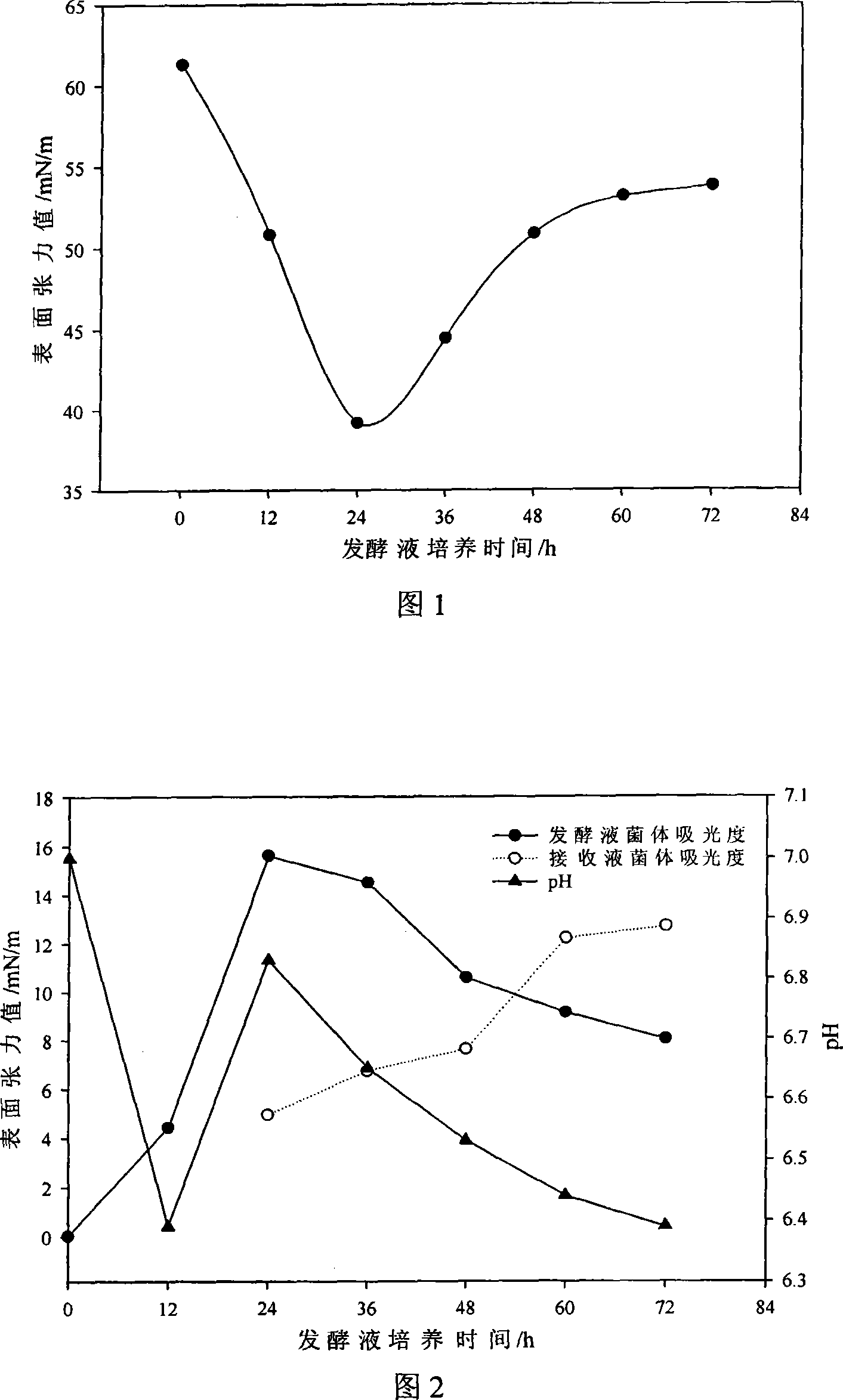Composite type biological surfactant and its production method
A biosurfactant and active agent technology, applied in chemical instruments and methods, transportation and packaging, chemical/physical processes, etc., can solve the problem that microorganisms cannot grow well at the same time, so as to improve the microenvironment of composting, increase types, and promote composting. Effect of Contact Density and Intensity
- Summary
- Abstract
- Description
- Claims
- Application Information
AI Technical Summary
Problems solved by technology
Method used
Image
Examples
Embodiment 1
[0019] Embodiment 1: produce composite biosurfactant
[0020] The bacterial classification used in the present invention is Bacillus subtilis (numbering CCTCC Bacillus subtilis AB93108), and this bacterial classification is purchased from China Typical Culture Collection Center, and is inoculated once on the slant medium every 1 to 2 months, and bacterial classification is in 4 Store under ℃ conditions. Take the refrigerated strains and activate them at 30°C for 24 hours, and then use an inoculation loop to pick a ring of strains from the slant culture medium in the aseptic operating table and inoculate them into the seed culture solution, which was pre-heated in a high-pressure steam cooker at 115 Sterilize at ℃ for 30min. The inoculated seed culture solution was placed in a constant temperature incubator for cultivation at 30° C. and 200 rpm. The composition of the seed culture solution is: NaCl 5.0g, peptone 5.0g, beef powder 3.0g, distilled water 1000mL, and adjust the p...
Embodiment 2
[0024] Embodiment 2: produce composite biosurfactant
[0025] As in Example 1, take the strains refrigerated at 4°C and activate them at 37°C for 24 hours, then use an inoculation loop to pick a ring of strains from the slant culture medium in the aseptic operating table and inoculate them in the seed culture solution, and the seeds are cultivated The solution was sterilized in a high-pressure steam cooker at 115°C for 30 min in advance. The inoculated seed culture solution was placed in a constant temperature incubator for cultivation at 37° C. and 250 rpm. The composition of the seed culture solution is: NaCl 4.0g, peptone 4.0g, beef powder 2.5g, distilled water 1000mL, and adjust the pH to 7.2 with 1M NaOH.
[0026] Inoculate the seed culture solution cultivated for 24 hours into the fermentation medium at an inoculum size of 5% by volume fraction, and the fermentation solution is composed of: glucose 45g, NH 4 NO 3 7.3g, K 2 HPO 4 ·3H 2 O 14.3g, NaH 2 PO 4 ·H 2 O...
Embodiment 3
[0030] Composition and properties of the prepared biosurfactant of embodiment 1 and 2:
[0031] 1. Lipids content
[0032] Take 0.15g of biosurfactant, dissolve and extract lipids with 6.0mL chloroform / methanol (V:V=2:1) mixed solution, then centrifuge at 7332×g for 10min, collect the supernatant, and the residue in the centrifuge tube Extraction was continued by the above method, repeated 3 times. The collected organic extract phase was rotatively evaporated at 46° C., weighed, and the mass percentage of lipid in the biosurfactant was determined to be 98.1±0.2%. Because this method utilizes the solubility of lipids in organic matter, the measured lipid content is pure lipids and their combinations with other substances (such as lipopeptides, lipoproteins or glycolipids, etc.) of the total mass percentage.
[0033] 2. Protein content
[0034] The protein content in the biosurfactant was determined by the Coomassie brilliant blue method, bovine serum albumin was used as a...
PUM
| Property | Measurement | Unit |
|---|---|---|
| Surface tension | aaaaa | aaaaa |
| Surface tension value | aaaaa | aaaaa |
Abstract
Description
Claims
Application Information
 Login to View More
Login to View More - R&D
- Intellectual Property
- Life Sciences
- Materials
- Tech Scout
- Unparalleled Data Quality
- Higher Quality Content
- 60% Fewer Hallucinations
Browse by: Latest US Patents, China's latest patents, Technical Efficacy Thesaurus, Application Domain, Technology Topic, Popular Technical Reports.
© 2025 PatSnap. All rights reserved.Legal|Privacy policy|Modern Slavery Act Transparency Statement|Sitemap|About US| Contact US: help@patsnap.com


